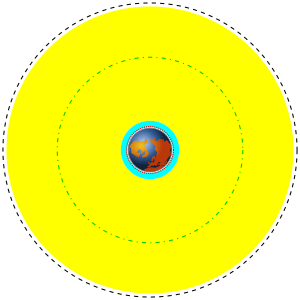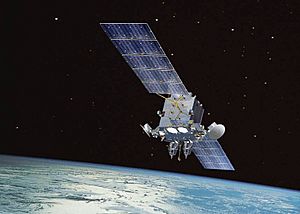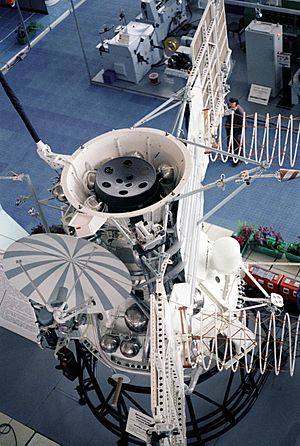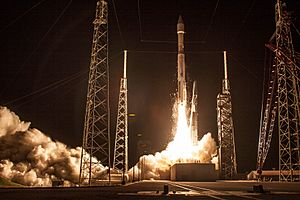Communications satellite facts for kids
A communications satellite is a special artificial satellite that helps send and boost radio signals. It acts like a relay station in space, creating a connection between a sender and a receiver on Earth. These satellites are used for many things like television, phone calls, radio, internet, and even military communications. There are over 2,000 communications satellites orbiting Earth, used by both private companies and governments.
Wireless communication uses invisible waves to carry signals. These waves need a clear path, but the Earth's curve blocks them over long distances. Communications satellites solve this problem by sending the signal around the Earth's curve. This allows people far apart to communicate. Satellites use different radio and microwave frequencies. To stop signals from getting mixed up, international rules decide which frequencies different groups can use.
Contents
How did communication satellites start?
The idea of a satellite that stays in one spot in the sky was first suggested by Arthur C. Clarke in 1945. He wrote an article called "Extraterrestrial Relays" that explained how satellites could orbit Earth to relay radio signals. Because of this, Arthur C. Clarke is often called the inventor of the communications satellite.
Before satellites, the United States Navy tried using the Moon to bounce radio signals. This project was called Communication Moon Relay. It aimed to create a safe way to communicate wirelessly.
The first artificial satellite was Sputnik 1, launched by the Soviet Union in 1957. It had a radio transmitter, but its main goal was to explore space, not to send messages between places on Earth. Still, it was a big step towards today's satellite communications.
What was the first communication satellite?
The first satellite made just for global communications was a giant balloon called Echo 1. Launched by NASA in 1960, Echo 1 was a huge, 100-foot-wide balloon made of shiny material. It worked like a giant mirror in space, reflecting radio signals from one point on Earth to another. This simple idea helped create the foundation for modern satellite communication.
The first American satellite to actually relay messages was Project SCORE in 1958. It recorded voice messages and then played them back later. President Dwight D. Eisenhower even used it to send a Christmas greeting to the world! After that, Courier 1B launched in 1960. It was the first satellite that could actively receive and re-send signals.
What are passive and active satellites?
There are two main types of communication satellites: passive and active.
- Passive satellites only reflect signals. They don't make the signal stronger. Because the signal travels so far, it becomes very weak by the time it reaches Earth. Echo 1 was a passive satellite.
- Active satellites make the signal stronger before sending it back to Earth. This means the signal received on the ground is much stronger.
Passive satellites were used first, but active satellites are used almost exclusively today. Telstar was an early active satellite. It was launched in 1962 as part of a big international effort to develop satellite communications.
Syncom 2, launched in 1963, was the first communications satellite in a geosynchronous orbit. This meant it orbited Earth at the same speed as Earth's rotation. Its successor, Syncom 3, launched in 1964, was the first geostationary satellite. It appeared to stay in the same spot in the sky, making it much easier to use.
Even today, space probes on Mars use orbiting spacecraft as communication satellites. These orbiters help send data from the Mars rovers back to Earth. They have bigger antennas and stronger transmitters, which saves power for the rovers on the surface.
Where do satellites orbit?
Communications satellites usually fly in one of three main types of orbits:
- Geostationary orbit (GEO) satellites are about 35,786 kilometers (22,236 miles) from Earth. These satellites seem to stay still in the sky because they orbit at the same speed as Earth rotates. This is great because ground antennas don't need to move to track them. They can just point to one spot.
- Medium Earth orbit (MEO) satellites are closer, ranging from 2,000 to 35,786 kilometers (1,243 to 22,236 miles) above Earth.
- Low Earth orbit (LEO) satellites are the closest, from about 160 to 2,000 kilometers (99 to 1,243 miles) above Earth.
Satellites in MEO and LEO orbits move faster across the sky. They don't stay in one place like GEO satellites. So, to have continuous communication with these lower orbits, you need many satellites working together. However, because they are closer to Earth, their signals are stronger.
Low Earth Orbiting (LEO) satellites

A LEO is usually a circular orbit about 160 to 2,000 kilometers (99 to 1,243 miles) above Earth. It takes about 90 minutes for a LEO satellite to go around the Earth.
Because they are so low, these satellites can only be seen from about 1,000 kilometers (621 miles) around the point directly below them. Also, LEO satellites move quickly across the sky. So, if you need constant connection, you need a lot of them.
LEO satellites are cheaper to launch than geostationary satellites. And because they are closer to the ground, their signals don't need to be as strong. This means there's a balance between how many satellites you need and how much they cost.
What is a satellite constellation?
A group of satellites working together is called a satellite constellation. Two famous constellations that provide satellite phone services, especially in remote areas, are Iridium (with 66 satellites) and Globalstar.
Some LEO satellites can also store data received over one part of Earth and then send it later when they pass over another part. This is called "store and forward."
Medium Earth Orbit (MEO) satellites
A MEO satellite orbits between 2,000 and 35,786 kilometers (1,243 and 22,236 miles) above Earth. MEO satellites are similar to LEOs but are visible for much longer, usually 2 to 8 hours. They also cover a larger area than LEO satellites. This means you need fewer MEO satellites for a network than LEO satellites.
One drawback is that MEO satellites are farther away, so their signals are a bit weaker and have a slightly longer delay than LEOs. However, these issues are not as big as with GEO satellites. MEO satellites do not stay in a fixed spot in the sky like GEO satellites.
Example of a MEO satellite
In 1962, the first communication satellite, Telstar, was launched. It was a MEO satellite designed to help with fast phone signals. Its main problem was that it didn't stay in one place. It orbited Earth in about 2.5 hours, while Earth takes 24 hours to spin. This meant it couldn't provide continuous coverage. It became clear that many MEO satellites were needed to keep a constant connection.
Geostationary orbits (GEO)
To someone on Earth, a satellite in a geostationary orbit looks like it's not moving. This is because it goes around the Earth at the exact same speed that Earth spins (360 degrees every 24 hours), and it stays over the equator.
Geostationary orbits are very useful for communications. Ground antennas can be pointed at the satellite and don't need to move. This makes the ground equipment much cheaper.
Examples of GEO satellites
- The first geostationary satellite was Syncom 3, launched in 1964. It was used to send TV coverage of the 1964 Summer Olympics across the Pacific Ocean.
- Soon after, Intelsat I, also known as Early Bird, was launched in 1965. It was the first geostationary satellite for phone calls over the Atlantic Ocean.
- In 1972, Canada launched its first geostationary satellite, Anik A1. The United States followed with Westar 1 in 1974.
- In 1975, Satcom 1 was launched. It was very important for early cable TV channels like TBS and HBO. These channels used Satcom 1 to send their programs to local cable TV stations. It was also the first satellite used by major TV networks like ABC, NBC, and CBS to send programs to their local stations. Satcom 1 was popular because it had twice as many communication channels (called transponders) as its competitor, making it cheaper to use.
By the year 2000, Hughes Space and Communications had built almost 40% of the world's satellites. Other big satellite makers include Space Systems/Loral, Lockheed Martin, and Thales Alenia Space.
Molniya satellites
Geostationary satellites must stay above the equator. This means they appear lower in the sky the farther you are from the equator. For places near the North or South Pole, a geostationary satellite might even be below the horizon, making communication difficult.
To solve this problem, especially in Russia, Molniya orbit satellites were launched. A Molniya orbit is very tilted. This allows the satellite to spend most of its time high in the sky over northern areas. It takes half a day to complete one orbit. This means a satellite can be used for 6 to 9 hours every other orbit. A group of three Molniya satellites can provide continuous coverage.
The first Molniya satellite was launched in 1965. It was used to send TV signals from Moscow to far-off places in Siberia and the Russian Far East.
Polar Orbit
Some satellites, like those managed by the National Polar-orbiting Operational Environmental Satellite System (NPOESS) in the United States, use a polar orbit. These satellites fly over the Earth's poles. They are "sun synchronous," meaning they cross the equator at the same local time each day. For example, some NPOESS satellites cross the equator going north at 1:30 PM, 5:30 PM, and 9:30 PM.
What are satellites made of?
Communications satellites usually have these main parts:
- Communication Payload: This includes the transponders (which receive and send signals), antennas, and switching systems.
- Engines: These are used to move the satellite into its correct orbit.
- Station Keeping: This system keeps the satellite in the right orbit, points its antennas correctly, and aims its solar panels at the sun.
- Power System: This powers the satellite, usually with solar cells and batteries that work when the sun isn't shining on the satellite.
- Command and Control: This system communicates with ground stations on Earth. These ground stations watch how the satellite is working and control it throughout its life.
The amount of data a satellite can handle depends on how many transponders it has. Different services like TV, voice, or internet need different amounts of data capacity.
How are satellite frequencies decided?
Deciding which frequencies satellites can use is a complex process that needs international teamwork. The International Telecommunication Union (ITU) handles this. The world is divided into three regions for frequency planning:
- Region 1: Europe, Africa, former Soviet Union, and Mongolia.
- Region 2: North and South America, and Greenland.
- Region 3: Asia (except Region 1 areas), Australia, and the southwest Pacific.
Within these regions, frequency bands are given to different satellite services. Some services provided by satellites include:
- Broadcasting TV and radio.
- Mobile phone services.
- Satellite navigation (like GPS).
- Weather forecasting.
- Amateur radio.
What are communication satellites used for?
Telephone calls
One of the first and most important uses for communication satellites was for long-distance phone calls between continents. Phone calls from land line phones would go to an earth station, then to a geostationary satellite, and back down to another earth station. However, new fiber-optic cables under the ocean have reduced the need for satellites for fixed phone calls.
Still, satellites are very important for phone calls in many places today. Remote islands like Ascension Island and Easter Island rely on satellite phones because they don't have underwater cables. Large parts of South America, Africa, Canada, China, Russia, and Australia also use satellite communications where landline phones are rare. Ships at sea and planes also use satellite phones.
Satellite phone systems can connect directly to satellites in either geostationary or low-Earth orbits. Calls are then sent to a satellite ground station that connects to the regular phone network.
Television
Television became a major use for satellites because it needed to send a few strong signals to many receivers at once. In North America, two types of satellites are used for TV and radio: Direct broadcast satellite (DBS) and Fixed Service Satellite (FSS).
- Fixed Service Satellites (FSS) use specific frequency bands. They are usually used to send TV programs between networks and local stations. They are also used for distance learning, business TV, and video calls. FSS satellites also send national cable channels to cable TV companies.
- Direct Broadcast Satellites (DBS) send signals directly to small satellite dishes (usually 18 to 24 inches wide) at people's homes. DBS technology is used for services like DirecTV and DISH Network in the United States.
FSS satellites need much larger dishes to receive signals (1 to 2.5 meters or 3 to 8 feet wide). DBS satellites use a different kind of signal that allows for smaller dishes.
Some newer satellites use even higher frequency bands. There are also special antennas for mobile reception of DBS television. These antennas use GPS technology to automatically point to the satellite, even when the vehicle is moving. This is popular with RV owners and airlines like JetBlue.
Radio broadcasting
Satellite radio offers audio broadcasting services in some countries, especially the United States. Services like SiriusXM allow listeners to travel across a continent and listen to the same audio programs everywhere.
A satellite radio signal is a digital radio signal sent by a communication satellite. It covers a much larger area than regular ground-based radio signals.
Satellite radio is a good option in places where regular radio signals don't reach well. These services are usually subscription-based and require special equipment to receive the signals. They offer many channels, including news, weather, sports, and music (often without commercials).
In areas with many people, it's usually cheaper to use ground-based radio. So, in some countries, new radio services focus on digital audio broadcasting (DAB) rather than satellite radio.
Amateur radio
Amateur radio operators can use amateur satellites. These satellites are designed specifically for amateur radio traffic. Most of them act as repeaters in space, receiving signals and sending them back out. Amateurs usually use special radio equipment and antennas to talk through these satellites. Because launching satellites is expensive, most amateur satellites are in low Earth orbits and can only handle a limited number of short conversations at a time.
Internet access
Since the 1990s, satellite communication has been used to provide Internet access through broadband connections. This is very helpful for people in remote areas who can't get regular broadband or need a very reliable connection.
Military use
Communications satellites are also used for military communications. Examples include systems for global command and control. Many countries, including the United States, NATO, the United Kingdom, and India, have their own military communication satellites. These satellites typically operate on specific frequency bands for secure communications.
Images for kids
-
A diagram showing a Geostationary orbit.
See also
 In Spanish: Satélite de comunicaciones para niños
In Spanish: Satélite de comunicaciones para niños









